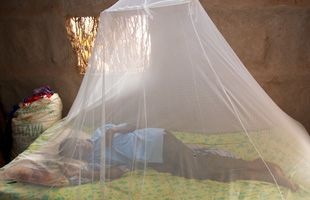What Is Malaria?
Malaria is a preventable and treatable mosquito-borne illness. In 2013, 97 countries had ongoing malaria transmission. There were an estimated 207 million cases of malaria in 2012 (uncertainty range: 135 – 287 million) and an estimated 627 000 deaths (uncertainty range: 473 000 – 789 000). 90% of all malaria deaths occur in sub-Saharan Africa, and 77% occur in children under five. Between 2000 and 2012, an estimated 3.3 million lives were saved as a result of a scale-up of malaria interventions. 90%, or 3 million, of these lives saved are in the under-five age group, in sub-Saharan Africa.
There is currently no commercially available malaria vaccine, despite many decades of intense research and development effort. The most advanced vaccine candidate against Plasmodium falciparum is RTS,S/AS01. A large clinical trial with 15 460 children is ongoing in the following seven countries in sub-Saharan Africa: Burkina Faso, Gabon, Ghana, Kenya, Malawi, Mozambique, and the United Republic of Tanzania.
The clinical trial data for WHO to consider making a policy recommendation is expected to be made available to WHO in late 2014. Depending on these full phase 3 results, the first WHO policy recommendations on use may occur in 2015. The policy timings depend on the outcome of the regulatory process with the European Medicines Agency.
Originally launched in 2006, The Malaria Vaccine Technology Roadmap has been updated in November 2013. The updated Roadmap represents a blueprint for second generation malaria vaccine development, including a new Vision, two new Strategic Goals and 13 priority activities, funding of which will be critical for successful development of a next generation of malaria vaccines by 2030.
Malaria is caused by a parasite called Plasmodium, which is transmitted via the bites of infected mosquitoes. In the human body, the parasites multiply in the liver, and then infect red blood cells.
Symptoms of malaria include fever, headache, and vomiting, and usually appear between 10 and 15 days after the mosquito bite. If not treated, malaria can quickly become life-threatening by disrupting the blood supply to vital organs. In many parts of the world, the parasites have developed resistance to a number of malaria medicines.
Key interventions to control malaria include: prompt and effective treatment with artemisinin-based combination therapies; use of insecticidal nets by people at risk; and indoor residual spraying with insecticide to control the vector mosquitoes.
Treatment
Malaria is an entirely preventable and treatable disease. The primary objective of treatment is to ensure a rapid and complete elimination of the Plasmodium parasite from the patient’s blood in order to prevent progression of uncomplicated malaria to severe disease or death, and to chronic infection that leads to malaria-related anaemia. From a public health perspective, treatment is meant to reduce transmission of the infection to others, by reducing the infectious reservoir and to prevent the emergence and spread of resistance to antimalarial medicines.

Vector control and insecticide resistance
Vector control is a fundamental element of the existing global strategy to fight malaria. Vector control interventions have a proven track record of successfully reducing or interrupting disease transmission, particularly in areas that are highly prone to malaria. Indoor residual spraying (IRS) and long-lasting insecticidal nets (LLINs) are the two core, broadly applicable malaria vector control measures. This section covers both core and supplementary vector control methods and discusses the action that is required to prevent and manage the increasing challenge of malaria vector resistance to insecticides.





